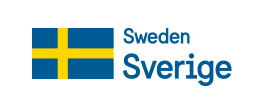Guide: Address poverty and gender in marine spatial planning
This guide will help you design a socially sustainable marine spatial planning process, with focus on poverty and gender equality.
By following the steps in this guide, you will ideally be able to design an inclusive process and a marine spatial plan that:
- does not worsen poverty and gender inequality
- appropriately considers and engages potentially marginalized groups in the planning
- makes your marine spatial plan socially sustainable.
Central concepts in this guide
Poverty – not only lack of money
When we write poverty in this guide, we do not mean only lack of money.
Instead, we include four things in poverty:
- Power and voice
- Resources
- Opportunities and choice
- Human security
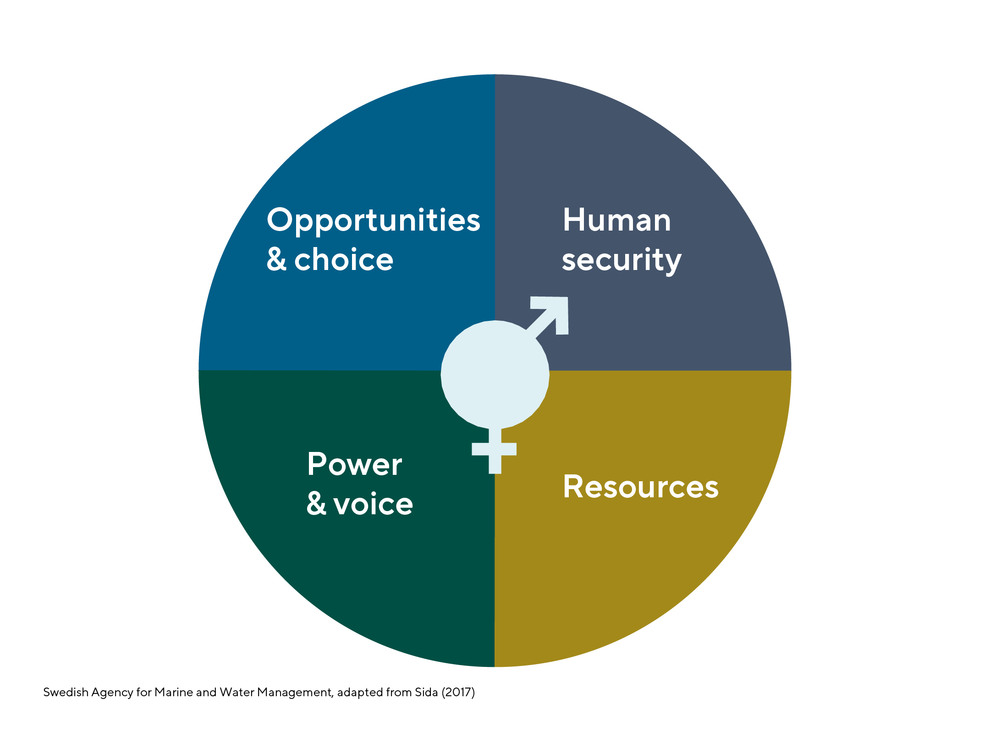
This means that someone can be rich or poor in these four ways.
Gender equality is equality
Equality is about the equal value and rights of all people. Gender equality is achieved when women and men, girls and boys, have equal rights, life prospects and opportunities, and the same power to shape their own lives.
You can analyse gender relations in a society – and the inequalities therein – by asking:
- Who does what?
- Who has what?
- Who decides, and how?
- Who gains?
- Who loses?
Empowerment of women is a key strategy for accelerating poverty reduction as well as for addressing the biodiversity and climate crises. Global goal 5 is to achieve gender equality and empower all women and girls.
Social dimension of sustainable development
Social sustainability can be conceptualised as being based on three key dimensions of recognition, representation, and distribution.
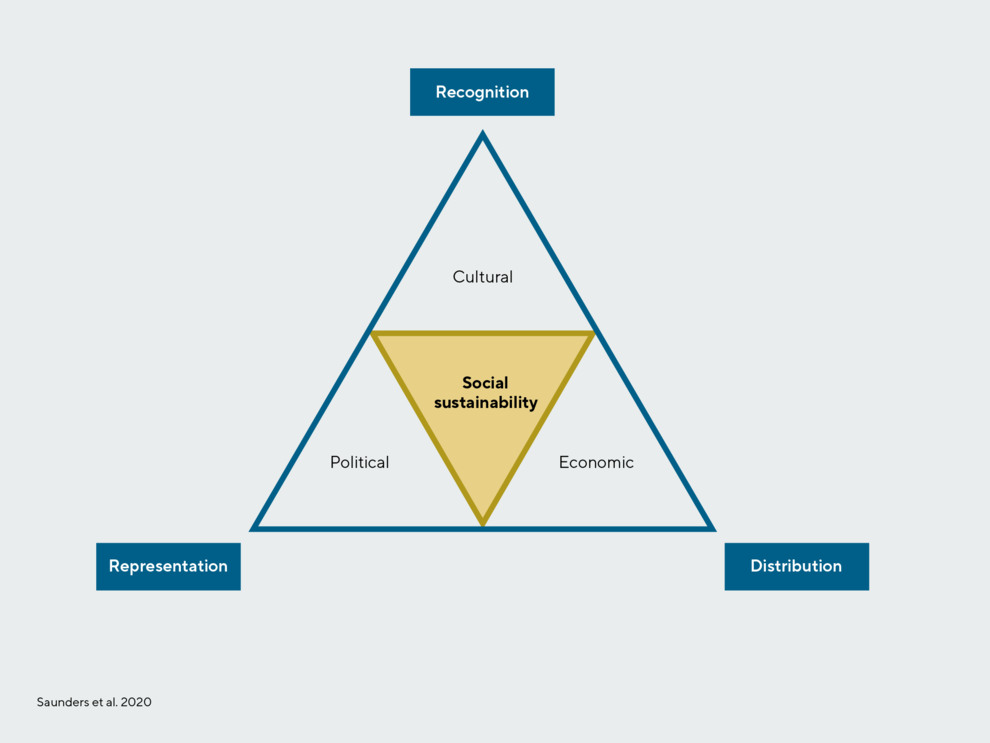
Recognition
Recognition deals with respect in relation to socio-cultural diversity of the group for example rights, needs, livelihoods, lifestyles, and knowledge –cultural influences category.
This can be seen as what information is taken into account in devising and evaluating options.
Representation
Representation deals with who is included or excluded in decision making, as well as the how and time inclusion indecision making – political influences category.
This is reflected in the way in which stakeholders are engaged in the process.
Distribution
Distribution is concerned with how risks, benefits, pollutants, capacities, and resource or experiences are distributed, particularly in relation to already disadvantaged groups – economic influences category.
This is reflected in the outcome of the process – how the various benefits and costs of the marine spatial plan are distributed among different actors.
Social sustainability in MSP – step by step
In order to achieve a socially-sustainable outcome, the process requires an approach for:
- identifying potentially marginalised communities or groups
- describing their current position
- describing the impacts of alternative planning options
- evaluating the outcomes
This requires conscious efforts in almost all steps of your MSP process.
8 steps for social sustainability
This guide will walk you through eight steps for social sustainability in marine spatial planning, step by step. The steps relate to the general MSP steps of preparation, assessments, and outcome and review.
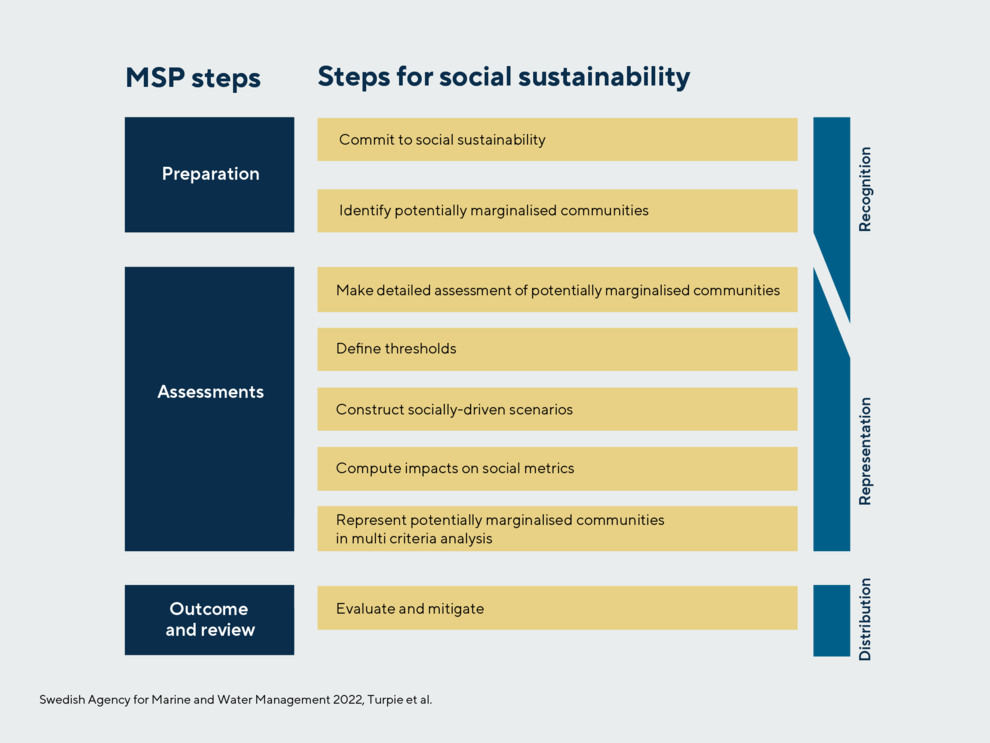
Taking these steps will help you meet the requirements of recognition, representation and distribution.
1. Commit to social sustainability
Commit to social sustainability. This is the first and most important step, making sure you include the social perspective in your process.
It is the government that should commit to social sustainability, and meeting the requirements for social sustainability.
2. Identify potentially marginalised communities or groups
Identify potentially marginalised communities or groups. Those are communities or groups in which the community as a whole, or a subset of the community, can be characterised as:
- having an absence of power and voice in influencing government policy,
- and being potentially affected by the MSP.
These could include any communities or groups in which a significant proportion of people would be defined as poor, such as:
- communities that are generally income poor
- communities in which women with limited alternatives depend on direct consumptive use of marine resources or on employment in a marine industry
- ethnic or religious groups that may be marginalised
Map and describe the communities
Map the communities based on their connection to marine habitats and activities, their property rights and any other relevant input from spatial data and census.
Describe the communities in terms of average household income, main livelihoods and primary links to the marine environment.
Note uncertainties and data gaps, because you might need to fix that in the next step.
This initial description forms the basis for step 3 where you will make detailed assessments, create criteria and collect data.
Identify stakeholder representatives
Identify stakeholder representatives for each community or group that will participate in the MSP process.
3. Make detailed situation assessment, including opportunities and threats
This step forms the baseline for your analysis.
Here you should seek to provide more data and more depth. The point is to be able to describe how the wellbeing of communities and groups will be affected by your marine plan, possible alternative plans, and the "business-as-usual" alternative.
You could include the following activities in this step:
- collect existing data
- do field studies and modelling
- describe the communities or groups in terms of a range of relevant characteristics
Seek to collect key information related to social wellbeing
Seek to collect data and information to describe the communities and groups in terms of relevant characteristics relating to household wellbeing and women wellbeing.
Also, collect the information that will be required to estimate how their wellbeing will change under a business-as-usual scenario and in response to different alternative plans.
You should also investigate how these communities perceive threats and opportunities in the marine realm, drawing on their indigenous knowledge.
In this step, you can also make use of some of the information being collected elsewhere in the MSP process on the expected economic impacts and environmental impacts of different activities, and the impacts of climate change.
How to create criteria for description, decision-making and evaluation
To be able to describe the impact of different scenarios you will need to identify relevant criteria for the data collection.
Criteria can be grouped into the three dimensions of sustainability: social, economic and environmental.
Under the social dimension, the criteria can be grouped into social wellbeing, with two sub-groups household prosperity and gender equality. Other sub-groups could be added.

Household prosperity and gender equality is the positive equivalents of poverty and gender problems.
Criteria for prosperity and gender equality
Chose criteria matching the four dimensions of poverty:
- resources
- opportunities and choice
- power and voice
- security
How to choose criteria
Chose criteria that are mutually independent, sufficient but not excessive in number and operationally meaningful.
The impacts of a scenario can usually be communicated in terms of relatively few, primary criteria, since many factors that contributes to societal wellbeing are often strongly correlated.
Example:
Criteria for the evaluation of the wellbeing of affected communities or groups
| Criteria | Household prosperity / poverty | Gender equality |
|---|---|---|
| Resources | Annual income (including subsistence) | Women’s share of income |
| Opportunities and choice | Access to education, healthcare, electricity and water, markets | Women’s’ share of the job market |
| Power and voice | Household representation in decision-making bodies Perception of voice | Women’s representation in decision-making bodies Women’s decision power in the household |
| Security | Community peace and harmony | Household peace and harmony |
How to collect data
Based on the identified criteria, you can collect data from different sources, such as:
- existing data
- focus group discussions and key informant interviews
- household surveys
Existing data
Collect and review existing data and information, for example:
- Social and population information from census data
- Ecological information from GIS data on geography, land cover, bathymetry, natural habitats such as reefs, mangroves, estuaries and lagoons, and marine protected areas
- Economic information complemented from land cover data and inspection of online map imagery, such as Google Earth.
Focus group discussions and key informant interviews
Conduct thematic focus group discussions and key informant interviews to collect information on different aspects of people’s livelihoods and their poverty and gender dimensions. This may allow you to collect information of a general nature to avoid unnecessarily lengthy household questionnaires.
Discussions can be semi-structured, following a discussion guideline.
Discussions and interviews can be conducted around subjects such as:
- Resource-harvesting and farming activities
- Economic opportunities and voice of local women
- Tourism
- Marine conservation
- Local economy
Participants should be reminded to speak on behalf of the entire community.
Template: Guiding checklist for focus group and key informant interviews
Household surveys
Household surveys could be your main source of data. A representative sample of households can be selected for face-to-face interviews with main decision-makers in the household.
Using data collection software and tablets instead of paper questionnaires will make it easier to handle a large number of interviews.
Designing the questionnaire
The household questionnaire can be divided into sections such as:
- Demographics and socio-economic background
- Residence and neighbourhood characteristics
- Employment and income
- Livelihood activities and income
- Security and voice
- Household perspectives on local conditions and development
Template: Household questionnaire
In the next step, the collected data will be used to define thresholds for the social sustainability and scenario analysis.
4. Define thresholds
Before moving on to describe scenarios in your MSP process, you will be helped by defining thresholds for the social outcome. This way any negative social changes can be flagged for mitigation in the scenario analysis.
Thresholds for the social criteria
Define thresholds for the social criteria that you used to describe the wellbeing of the communities or groups in step 3.
Base your thresholds on:
- Stakeholder input
- National policies
- Global goals for sustainable development
Example:
Thresholds for social criteria
- Maximum 10 percent negative change in annual income, relative to the business-as-usual scenario.
- No negative change in women’s share of income, relative to the business-as-usual scenario.
For comparison, an environmental threshold could be that a minimum area of 30 percent will be under protection.
A scenario can be considered viable if none of the thresholds are breached.
The broader process will also include economic and environmental thresholds.
5. Construct socially-driven scenarios
A MSP process involves analysis of scenarios in which changes are measured against the current baseline, or business-as-usual. Creating alternative scenarios helps you make decision in the MSP process.
By creating scenarios based on how they may affect potentially marginalised communities or groups, their wellbeing can be included in the analysis.
Create alternative scenarios
Alternative scenarios should be constructed with involvement of the local communities, and should ask how the wellbeing could change if the scenarios change.
Incorporate potential changes in the social, economic, and environmental dimensions. Political changes can also be taken into consideration when the scenarios are constructed.
Example:
Scenarios - business as usual and two alternative scenarios
Business-as-usual
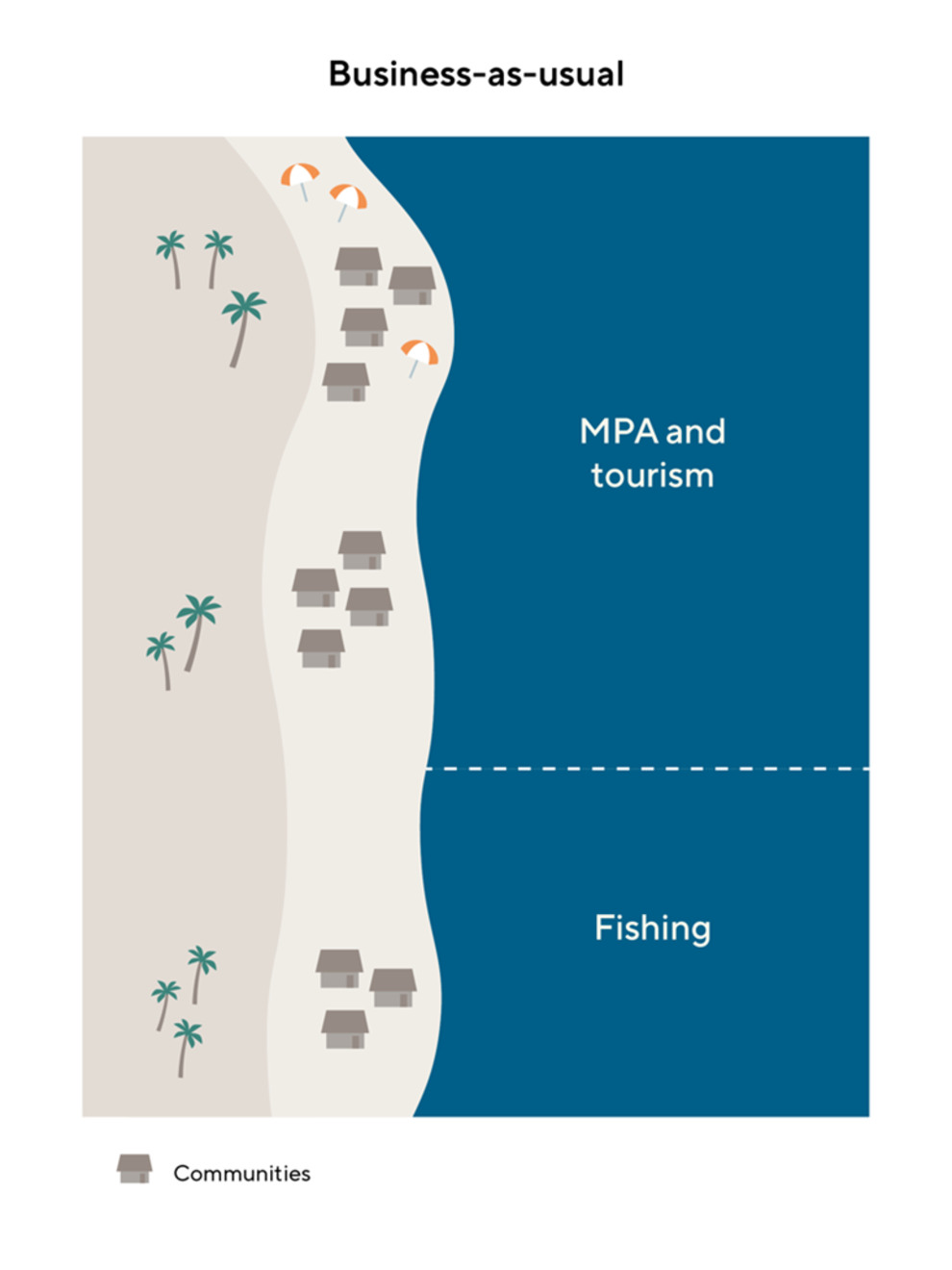
Scenario A: Mining
Mining in the middle, less MPA protected area and tourism, less space for fishing, compared to business-as-usual.
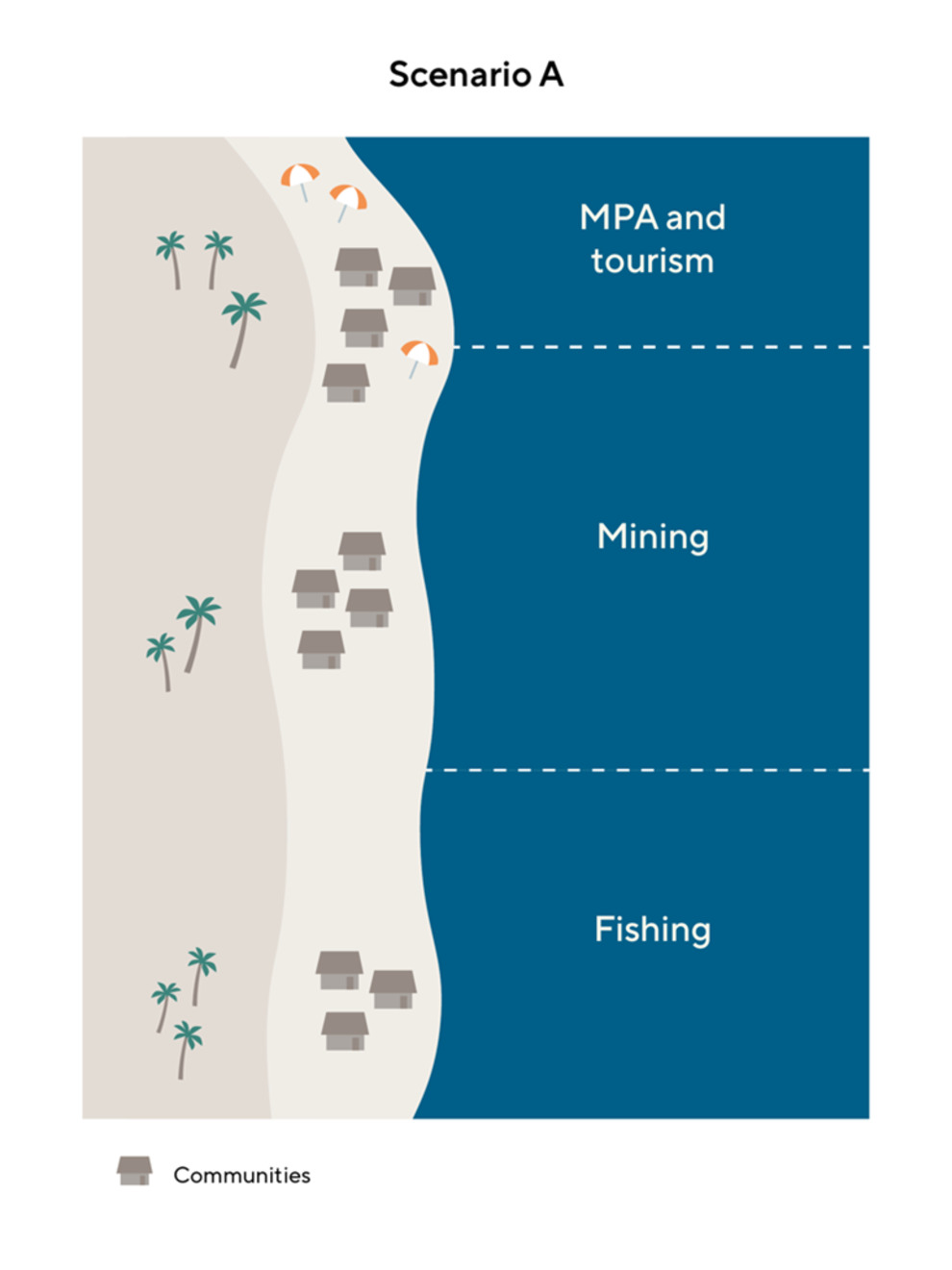
Scenario B: Smaller activities
Protection of certain inshore areas for small scale activities, including protection from activities outside the area that pose a threat to its resources.
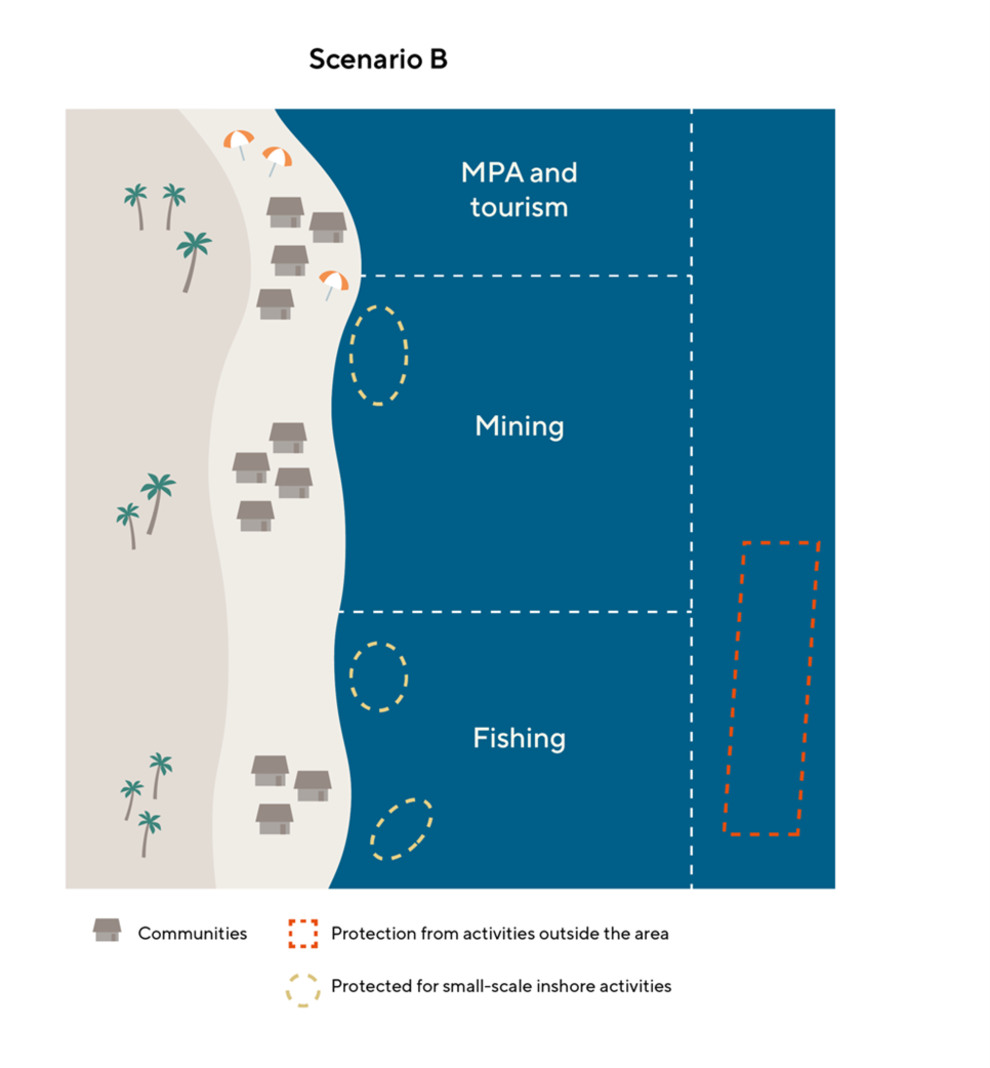
Strive to be comprehensive and clear
To be fully inclusive, your descriptions of business-as-usual and the different alternatives needs to be both comprehensive and accessible.
In the next step we will investigate how social metrics can be used to compute the impact as basis for scenario analysis.
6. Compute impacts on social metrics
In this step you will use the social data collected in step 3 to evaluate how your alternative scenarios impact the social metrics.
Example:
Metrics to model impacts of alternative scenarios
| Criteria | Household prosperity/poverty | Gender equality | Metrics to model impacts of plan alternatives |
|---|---|---|---|
| Resources | Annual income (including subsistence) | Women’s share of income |
|
| Opportunities and choice | Access to education, healthcare, electricity and water, markets | Women’s’ share of the job market |
|
| Power and voice | Household representation in decision-making bodies Perception of voice | Women’s representation in decision-making bodies Women’s decision power in the household | Inclusion in management strategies |
| Security | Community peace and harmony | Household peace and harmony | Sensitivity of security status to a change in marine-related access/income |
Once the alternative scenarios and metrics are constructed, you can explore:
- How would the social, economic, political and or environmental context change with business-as-usual and alternatives A and B, respectively?
- How would the alternatives affect the wellbeing of marginalised communities or groups?
- Could we change any alternative to get a better outcome?
How to evaluate the impact
Carry out the evaluation by using a heuristic approach with a combination of quantitative analysis, qualitative information, and expert understanding.
Let this inform the estimation of changes in the social metrics for each scenario.
Make the impacts clear
Present the predicted impacts of different alternatives in such a way that the implications for potentially marginalised communities or groups are made clear to all stakeholders.
Likewise, make your reasoning and assumptions clear, so that others can review them.
7. Represent potentially marginalised communities in multi-criteria analysis
To incorporate the preferences of potentially marginalised communities or groups, use a fully representative multi-criteria analysis. Multi-criteria analysis is an approach where scoring and weighting of relevant criteria is used, in a process involving stakeholders.
As comparison, a cost-benefit has limitations in terms of dealing with distributional issues and impacts that are difficult to express in monetary terms. Therefore, multi criteria analysis is better for supporting decision-making in MSP.
The multi-criteria analysis can ensure that the comparison of scenarios will include the consideration of how they impact the wellbeing of marginalized communities and groups.
Let stakeholders participate
Multi-criteria analysis requires the dedicated participation of a representative group of stakeholders who can define their objectives, devise a hierarchy of goals, criteria and their relative weightings, and score the alternatives in terms of those criteria to derive aggregate scores for each alternative.
Represent each stakeholder group in the multi-criteria analysis process.
How to construct your scoring
Include social, economic, and environmental dimensions.
Use a nested structure scoring, in which the scores for lower-levels are combined to produce weighted scores of higher-levels. The overall score then is the combination of all lower-levels scores.
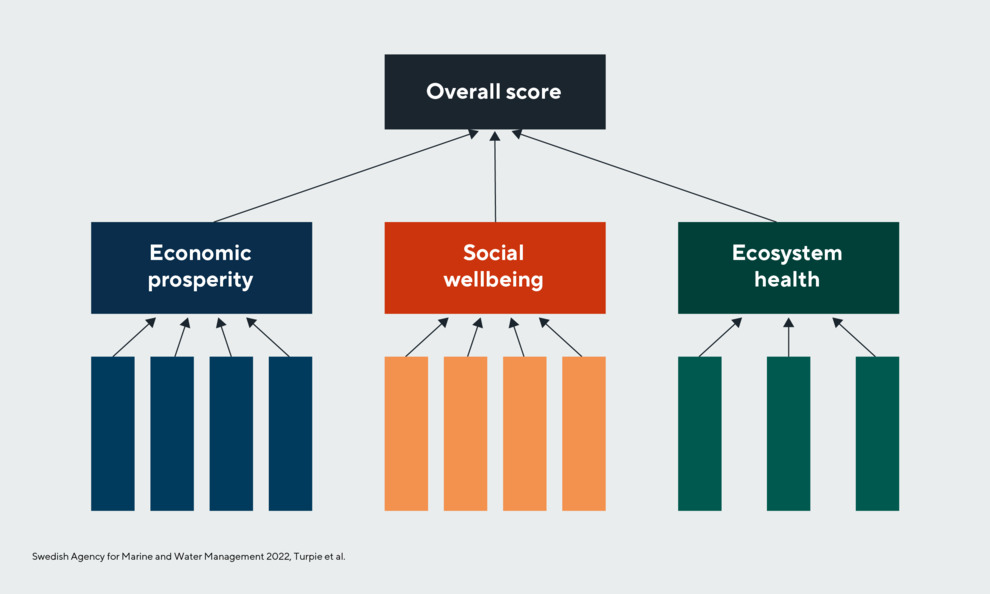
Example:
Weighting of the four dimensions of poverty – to use in multi criteria analysis
Criteria | Household prosperity/ poverty | Gender equality | Metrics to model impacts of plan alternatives | Weight in multi criteria analysis |
|---|---|---|---|---|
Resources | Annual income (including subsistence) | Women’s share of income |
| 40 |
Opportunities and choice | Access to education, healthcare, electricity and water, markets | Women’s’ share of the job market |
| 20 |
Power and voice | Household representation in decision-making bodies Perception of voice | Women’s representation in decision-making bodies Women’s decision power in the household | Inclusion in management strategies | 20 |
Security | Community peace and harmony | Household peace and harmony | Sensitivity of security status to a change in marine-related access/income | 20 |
Combine weights and scores for each scenario into an overall score
Combine the weights and scores for each of the alternative scenarios to derive an overall score. Examine and interpret the results.
You can consider a scenario viable if none of the thresholds are breached in it.
Choose a plan to put forward
Choose a final marine spatial plan to put forward for decision to the leading authority.
Make sure that the final plan does not:
- breach any of the thresholds agreed
- deepen any of the dimensions of poverty for any stakeholder group
- compromise the welfare of women
- compromise social capital or cultural identity
8. Evaluate and mitigate
Once the marine spatial plan is adopted and is being implemented, you can evaluate the outcome of it in the real world.
Check how the plan impacts social metrics and thresholds
Check how the plan impacts the social metrics, and whether the impacts deviate from the expected. Use the methods, metrics, and indicators you used for the analysis.
Most importantly, check if any thresholds have been breached.
If the outcome deviates negatively, find the reasons, and try to design a solution that can improve it.
This evaluation relates to the distribution dimension of the social sustainability framework.
Evaluate the process
Evaluate your process to see who was included or excluded in the process and decision making, as well as to see what information was considered in creating and analysing the alternatives.
This kind of evaluation relates to recognition and representation dimension of the social sustainability framework.
Further reading and references
- Poverty and gender considerations in marine spatial planning - Conceptual and analytical framework, at SwAM
- MSPglobal International Guide on Marine/Maritime Spatial Planning, at UNESCO
- Gender, Marginalized People and Marine Spatial Planning – Improve livelihoods, empower marginalized groups, bridge the inequality gap, at WorldBank
- Social sustainability (Theorizing Social Sustainability and Justice in Marine Spatial Planning: Democracy, Diversity, and Equity. Sustainability, Vol. 12, No. 6, 2560) at MDPI
- MCA - Multi-Criteria Analysis, at ValuES Project
Improve this guide
Help us improve this guide: Give feedback
Get more results
This work is part of SwAM Ocean, our program for improving lives through sustainable use of the sea and our bilateral environmental and climate cooperation.
